The kettlebell is possibly the most functional piece of equipment that you can find in the gym. Sure, the dumbbell and barbell might be the most popular, but nothing beats the kettlebell when it comes to versatility. Anything you can do with normal weights you can do with the kettlebell. It’s perfect for anyone who wants to lean down, tone up or build some muscle.
Today, we’re going to look at 10 kettlebell exercises that are not only easy, but effective.
1. Kettlebell Clean
Whilst using almost every single muscle in your entire body, the kettlebell clean teaches you how to lift heavy things up to chest height.
Start with your feet slightly wider than hip width and the kettlebell between your feet. Bend down to grasp the top of the handle with one hand, push your hips back, and tighten your hamstrings. Make sure to maintain a rigid spine throughout the entire movement by engaging your core and keeping your eyes looking forward.
To ‘clean’ the kettlebell to your shoulders, engage your glutes and legs as you bring the kettlebell upwards. As the kettlebell comes up, rotate your wrist so that the kettlebell finishes resting against the back of your forearm.
The ending position should have you standing upright in a solid position with the arm that’s holding the kettlebell bent at the elbow.
2. Turkish Get-Up
Whilst the clean helps you to lift weights overhead whilst also training the posterior chain, the Turkish Get-Up helps to train your shoulders and core to handle heavy objects as you stand up.
The first thing to note about the Turkish Get-Up is that it isn’t one single movement. Instead, it’s a group of movements all completed one after the other to make up one full exercise.
Begin by lying on your side with the kettlebell in front of your chest. Your legs should be at a right angle as if you were sitting on a chair. The arm you’re choosing to work with should be gripping the kettlebell at the top whilst the other hand covers it. From here, roll onto your back and rest the kettlebell against your stomach.
Next, move the weight overhead so that your arm is perpendicular to the floor. If you’re strong enough, then you can use one arm, but you can also use two to make it easier. This isn’t part of the actual movement so do whatever feels best. Bend the knee on the side of the working arm with your foot flat against the floor. Your other arm should be about 45 degrees from the body and your opposing leg should be extended straight below you.
Now, take a deep breath in so that you brace your core. On your working side, press through your foot and roll onto the elbow of the extended arm. When you feel stable, extend your arm so that you’re on your hand. At the end of this position, your working leg should still be bent, your opposing leg is straight, your torso is upright, your working arm is overhead holding the weight, and your other arm is extended straight and diagonal from your body.
Engage your glutes to bring your hips away from the floor. Your hips should be high enough so that your straight leg can move underneath your body. At this point, the weight should be distributed evenly between one arm and the opposing leg.
After this, your straight leg needs to move underneath you into a kneeling position with your knee near to the hand on the floor. Make sure to keep your eyes looking at the weight with your core braced.
The next part is the final step. Bring your hand off the floor as you use your core to take your torso into an upright position. Now, bring your head so that you’re facing forward opposed to looking at the weight. Your legs should now be in the bottom part of a lunge, making it easy for you to push through your back foot into a standing position.
Slowly return to the starting position by doing movements in a reverse way. Repeat the exercise with the same or opposite arm.
3. Kettlebell Snatch
The kettlebell snatch is the clean’s older brother. Instead of taking the weight to chest height, you finish with it overhead.
Begin in the same starting position as the clean with your feet placed just wider than hip width and the weight in between. Lower hips, create tension in your hamstring and brace your core as you hold the kettlebell at the top of the handle.
Next, press through the balls of your feet and engage your glutes to bring the weight up with speed. Let the kettlebell take on its own momentum as it flies in front of your body. As it comes up, lower your body so that you can catch the weight above your head.
4. Kettlebell Swing
The kettlebell swing is the perfect movement for training the hips and legs to develop speed and power. This exercise not only burns a large amount of calories, but also creates stability in your core and strength in your lower body that will transition over to other movements.
Lift the weight with both hands and start with it hanging between your legs. Again, you want your feet placed hip width apart with your spine in a neutral position.
Bend slightly forward so that the kettlebell lowers. In this movement, your arms should just connect you to the bar. It’s your hips and legs that are being worked whereas your arms should act like strong wires.
Engage your glutes and hamstrings to slam your hips into your forearms, throwing the weight forward. The first swing will only be slight, but you can use it to gain momentum for the subsequent swings. When the kettlebell comes back towards you, move with it so that it can come as far back as possible. Engage your glutes again to push the weight forward. Each swing should be bigger than the last until your arms become parallel to the ground. If the weight goes above your shoulders, then it’s too light.
5. Goblet Squat
Just like with any squat, the goblet squat is a must if you want to develop your lower body. However, because the weight is in front of you, this trains your core to become strong and your hips to sink lower without your back rounding.
Holding either side of the handle, clutch the weight to your chest. Next, keeping your core tight, sink your hips between your heels. If you can’t do this, then take a wider stance. The aim is to get your body at least to the point where your hips are in line with your knees without your lower back rounding. At the bottom of the movement, press through the heels of your feet to bring yourself back into a standing position.
6. Single-Arm Row
The row builds core strength and stability alongside hitting each side of the upper back individually. This allows you to acknowledge any imbalances or weaknesses.
Start with the weight on the floor in front of you. Enter a lunge position with your back leg extended behind you and your front leg slightly bent. You want to bend over and grab the weight with the arm on the same side as your back leg. Place your other hand against your front knee so that you can brace your back.
Next, row the kettlebell towards your body by using your upper back and biceps. Before lowering it to the ground, ready for the next rep.
You can also do single-arm row in a traditional way where you place your knee (lower leg) on the bench.
7. Overhead Press
The weight above your head challenges you to stay in a stable position alongside building strength in your shoulders and arms.
Start with the weight in one hand resting against the same shoulder. Press through your palm to extend the weight overhead using your shoulders and triceps. Don’t flex or bend your spine sideways; try to keep it as rigid as possible. At the end of the motion, your arm should be extended fully with your muscles engaged to take pressure off your joints.
8. Kettlebell Halo
The halo is another movement that not only strengthens the shoulders, but helps to mobilise them to improve their mobility. For this reason, the kettlebell halo is also great for warming up the shoulders before an upper body session.
Hold either side of the kettlebell handles in front of your chest with a firm grip. Next, circle the weight around your head in one direction until you’ve completed the prescribed reps before going back in the other direction.
9. Kettlebell Push-Press
The push-press is a variation of the overhead press that uses the lower body to help you extend the weight above you. This not only means that you can lift a heavier weight, but it also involves the posterior chain to a greater degree.
Begin in the same position as the overhead press with the kettlebell racked against the inside of your shoulder. Squat slightly and engage your glutes to push the weight into the air. You don’t want to come off the ground, just use your hips to help you lift the weight overhead.
10. Kettlebell Lunge and Twist
This last exercise combines the Russian twist to train the abdominals and the lunge to hit your legs. The lunge is already a strong core exercise because of its unilateral nature, so adding in the twist only furthers the challenge for your abs and legs.
Begin by holding the kettlebell against your chest with your feet directly underneath you. Lunge forward with one leg, making sure that your front knee is above your front ankle and your back knee is below your hip. Your trailing knee should not touch the ground. At the bottom of the movement, rotate your torso one way and then the other using your abs. Return to looking forward and push through the heels of your front leg back into a standing position before repeating on the other side. In case of any back pain, try to avoid these torso rotations.
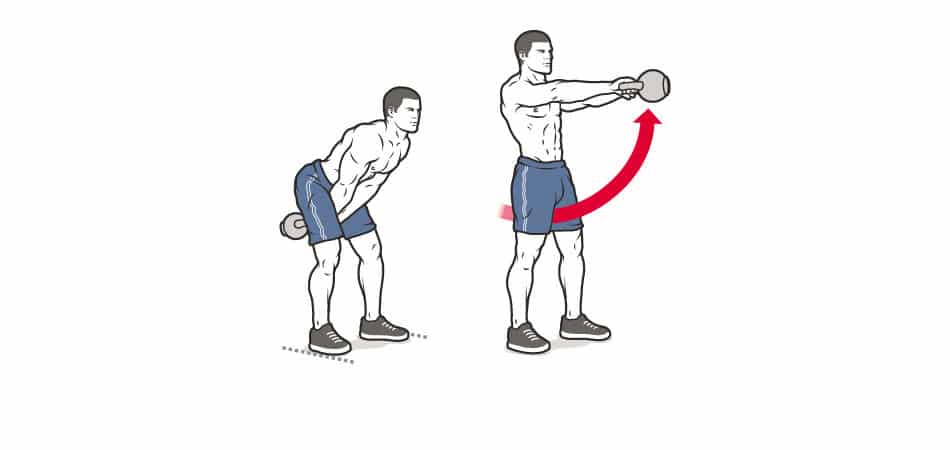
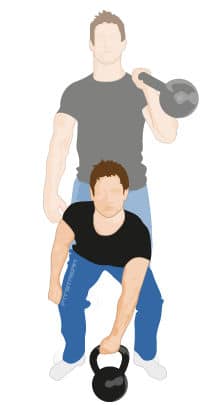
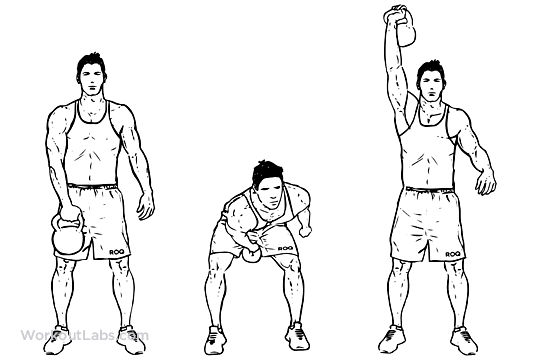
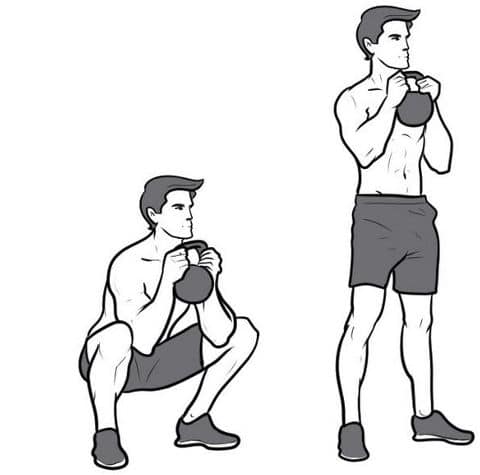
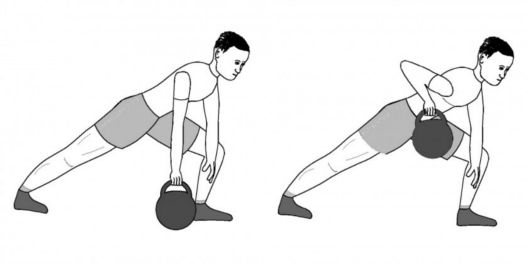
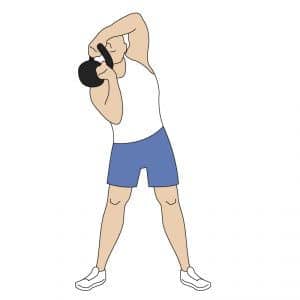
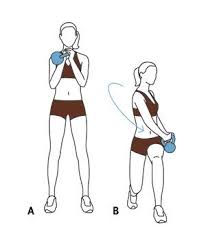
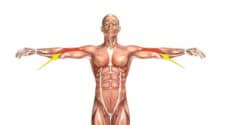
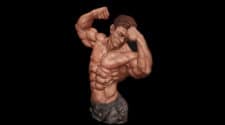
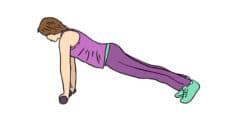
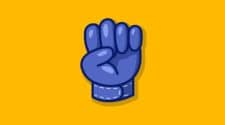


Leave a Reply